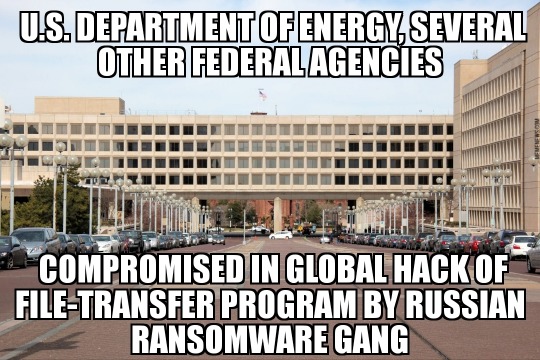#Department of Energy
Photo

2x2x4
349 notes
·
View notes
Text
Concept: the Mystery Flesh Pit existing in the SCP universe, yet it doesn't fall under SCP jurisdiction because it was originally sold to the National Parks Service, and despite the Mystery Flesh Pit since being shut down due to the incidents, the National Parks Service refuses to hand over jurisdiction to SCP because it's their mess to deal with and contain.
They allow SCP scientists to visit and share information, of course.
#SCP#scp foundation#mystery flesh pit#like#there are a select few government agencies that SCP fucks with#the department of interior#national parks service#IRS#department of energy#i Just like the idea that SCP is lowkey afraid of the National Parks Service
172 notes
·
View notes
Text
Maryland’s top utility regulator was watching the news one February morning when a headline blindsided him: Two suspects with neo-Nazi ties had been charged with plotting to take down Baltimore’s power grid.
Jason Stanek, the then-chair of the state’s Public Service Commission, said Maryland regulators were “caught flat-footed,” not hearing a word from law enforcement before the news broke — or in the months afterward. Federal prosecutors have alleged the defendants were driven by “racially motivated hatred” to try to cut power to hundreds of thousands of people in the state’s largest city, which has a predominantly Black population.
The FBI declined to comment on its communications with the Maryland commission. But Stanek’s experience is not uncommon.
A POLITICO analysis of federal data and interviews with a dozen security, extremism and electricity experts revealed that despite a record surge in attacks on the grid nationwide, communication gaps between law enforcement and state and federal regulators have left many officials largely in the dark about the extent of the threat. They have also hampered efforts to safeguard the power network.
Adding to the difficulties, no single agency keeps a complete record of all such incidents. But the attacks they know about have regulators and other power experts alarmed:
— Utilities reported 60 incidents they characterized as physical threats or attacks on major grid infrastructure, in addition to two cyberattacks, during the first three months of 2023 alone, according to mandatory disclosures they filed with the Department of Energy. That’s more than double the number from the same period last year. DOE has not yet released data past March.
— Nine of this year’s attacks led to power disruptions, the DOE records indicate.
— The U.S. is on pace to meet or exceed last year’s record of 164 major cyber and physical attacks.
— And additional analyses imply that the true number of incidents for both 2022 and 2023 is probably even higher. POLITICO’s analysis found several incidents that utilities had reported to homeland security officials but did not show up in DOE data.

According to a report on grid security compiled by a power industry cyber clearinghouse, obtained by POLITICO, a total of 1,665 security incidents involving the U.S. and Canadian power grids occurred last year. That count included 60 incidents that led to outages, 71% more than in 2021.
While that report does not break down how many of those incidents occurred in which country, the U.S. has a significantly larger grid, serving 145 million homes and businesses, with nearly seven times Canada’s power-generating capacity.
Law enforcement officials have blamed much of the rise in grid assaults on white nationalist and far-right extremists, who they say are using online forums to spread tactical advice on how to shut down the power supply.
Concerns about the attacks have continued in recent months, with incidents including a June indictment of an Idaho man accused of shooting two hydroelectric stations in the state.
But law enforcement officers investigating alleged plots against the grid don’t necessarily alert the Energy Department or other regulatory bodies.
“We have no idea” how many attacks on the grid are occurring, said Jon Wellinghoff, a former chair of the Federal Energy Regulatory Commission, which regulates the U.S. electric grid. “It looks like they’re escalating if you look at the data. But if you don’t have enough data, you can’t discern patterns and proactively work to stop these things from happening.”
Wellinghoff was FERC’s chair when an unknown sniper attacked a Pacific Gas and Electric substation in San Jose, Calif., in 2013 — an incident regulators have described as a “wake-up call” on the electricity supply’s vulnerability to sabotage.

Last year’s record number of physical and cyber disruptions to the U.S. power system included several incidents that captured public attention, such as a December shooting attack against two North Carolina substations that left 45,000 people without power for four days. The state’s medical examiner has blamed the attack for the death of an 87-year-old woman who died after her oxygen machine failed, ruling it a homicide. Nobody has been charged.
“There is no doubt there’s been an uptick over the last three years in the amount of incidents and also the severity of the incidents,” said Manny Cancel, senior vice president at the North American Electric Reliability Corp., the nonprofit body in charge of setting reliability standards for the bulk power system. He is also CEO of its Electricity Information Sharing and Analysis Center, which gathers and analyzes data from power companies.
Cancel said NERC has “seen two pretty substantial increases” in incidents coinciding with the 2020 and 2022 election cycles.
Grid attacks that led to power outages increased 71% from 2021 to 2022, totaling 55 incidents in 2022, according to a NERC briefing to utilities that POLITICO obtained. That increase was primarily due to a rise in gunfire assaults against critical infrastructure.
The largest outage reported from a physical attack early this year — which occurred in March in Clark County, Nev. — affected more than 11,000 people, according to DOE data.
But the state Public Utilities Commission was not aware of any outage due to an attack occurring that day, spokesperson Peter Kostes told POLITICO by email. That’s even though state regulations require utilities to contact the commission within four hours of a significant outage.
The state’s largest utility, NV Energy, said in a statement that it had reported the incident to local law enforcement “as soon as we learned about this incident ... so we can continue to increase our resilience against ongoing threats to the energy industry.” A spokesperson for the utility did not respond to multiple requests for comment on whether it had informed the commission.
Federal regulations also require utilities to report cyber or physical attacks to DOE, including physical attacks that cause “major interruptions or impacts” to operations.
They must also tell the department about disruptions from weather or other causes that meet certain criteria, such as those that cut off service to more than 50,000 customers for at least an hour, an uncontrolled loss of more than 200 megawatts of power, or a utility voluntarily shutting more than 100 megawatts, according to an Energy Department spokesperson. The spokesperson provided the information on the condition that they not be identified by name.
The Energy Department’s records don’t include at least seven reported physical assaults last year and this year that the Department of Homeland Security and the affected utilities said caused substantive economic damage or cut off power to thousands of customers. POLITICO found these incidents by cross-checking the department’s data against warnings issued by DHS and the FBI’s Office of the Private Sector.
DOE said the incidents may not meet its reporting thresholds.
Several of the incidents missing from DOE’s data involved clear physical attacks, based on other agencies’ descriptions. But the utilities involved said they did not report the incidents to the department because the attacks did not affect the kind of major equipment that could lead to widespread, regional power failures.
One of the incidents not found in DOE’s records cut off power to about 12,000 people for roughly two hours in Maysville, N.C., after a shooting damaged a substation in November, according to a DHS report. The FBI’s investigation into the incident is ongoing, according to the intelligence agency.
The utility affected by the incident, Carteret-Craven Electric Cooperative, reported the incident to NERC’s Electricity Information Sharing and Analysis Center, but didn’t report the attack to DOE because it was a “distribution-level” incident, said Melissa Glenn, a spokesperson for the utility. That means the outages caused by the damage would have been limited to local power customers and not lead to the wider blackouts federal regulators are most concerned with.
In another case unreported to the Energy Department, a substation owned by the East River Electric Cooperative serving the Keystone oil pipeline in South Dakota was attacked by gunfire late at night in July 2022, according to DHS. The incident caused more than $1 million in damage and forced the pipeline to reduce operations while repairs were underway.
East River co-op spokesperson Chris Studer said the utility reported the incident to local law enforcement, which brought in the FBI. East River also reported the incident to NERC and its E-ISAC, along with regional grid agencies, but said it did not report it to DOE because the attack did not affect the bulk power system.
Brian Harrell, a former assistant secretary for infrastructure protection at DHS, said in an email that utilities have too many competing agencies to report to, and suggested reporting be streamlined to NERC’s E-ISAC.
“This lack of consistency, by no fault of the utility, suggests that the numbers may not paint a complete picture,” he said.
Grid experts said these data gaps clearly indicate a lack of understanding about which agencies utilities need to report to and when.
Utilities may be using a “loophole” based on definitions of what constitutes “critical infrastructure,” said Jonathon Monken, a grid security expert with the consulting firm Converge Strategies. He was previously senior director of system resilience and strategic coordination for the PJM Interconnection, the nation’s largest power market.
There are “lots of ways” to work around DOE requirements, Monken added, but as he reads the regulation, utilities are required to report any operational disruptions caused by a physical attack.
“[I]t appears the information you collected shows that companies are still missing the boat when it comes to mandatory reporting,” he said. “Not good.”
One former FERC official who was granted anonymity to speak about a sensitive security issue said the commission also received no alerts from law enforcement officials about the planned and actual attacks that took place last year. That omission hinders agencies’ ability to respond to these kinds of events, the person said.
A spokesperson for FERC declined to comment on the commission’s communications with law enforcement.
But Cancel defended government agencies’ response to these incidents, and said federal investigators may have had specific intelligence reasons for keeping FERC and state utility agencies out of the loop.
“I’m not a lawyer or a law enforcement professional, but you had an active criminal investigation going on,” he said. “I don’t think they wanted to sort of blow the horn on that and compromise the integrity of the investigation.”
An FBI spokesperson offered no direct response to these criticisms in an email, but said the agency “views cybersecurity as a team sport.” The person commented on the condition that the remark be attributed to the bureau.
The FBI urged utility executives last month to attend security training hosted by intelligence agents in order to ensure they are up to speed on the threats posed by bad actors.
“We can’t do it without you,” Matthew Fodor, deputy assistant director of the FBI’s counterterrorism division, said during an all-day FERC technical conference on Aug. 10. “The challenges that we have — and DOE can probably speak to this better than anybody — is limited resources.”
People attacking the electricity supply have thousands of potential targets, including power substations and smaller but critical pieces of utility infrastructure. The smaller pieces often go unprotected because federal standards do not require utilities to secure them.
Nearly half of the 4,493 attacks from 2020 to 2022 targeted substations, according to the NERC briefing from February, making them the most frequent targets for perpetrators over that period.
Details on how to carry out these kinds of attacks are available from extremist messaging boards and other online content, researchers and federal security officials say. These include maps of critical entry points to the grid, along with advice that extremists have gleaned from incidents like the assault in North Carolina.
Stanek, the Maryland electricity regulator, said he was “disappointed with the level of coordination and communication” that federal and state law enforcement displayed in handling the alleged plot in Baltimore. No trial date has been announced for the case, which is in U.S. District Court in Maryland.
Maryland’s Public Service Commission is in charge of ensuring that the state’s power system keeps the lights on. Regulators need to be kept informed of threats to the system so they can coordinate with other agencies in case an attack succeeds, Stanek said.
At the same time, he quipped, maybe he was better off in the dark after all.
“There’s a lot of colorful details in [the FBI report],” Stanek said. He paused, thinking. “And honestly, as a regulator, had I received these details in advance and shared the information with trusted sources within state government, I would have had sleepless nights.”
“So perhaps the feds did a favor by only sharing this information after everything was all said and done,” he added.
#us politics#news#politico#2023#alt right#domestic terrorists#neo nazis#fbi#power grids#power outages#Department of Energy#canada#white nationalists#Federal Energy Regulatory Commission#US electric grid#North American Electric Reliability Corp.#Department of Homeland Security#Office of the Private Sector#counterterrorism#cybersecurity#utility infrastructure#maryland
75 notes
·
View notes
Text
Sam Britton stole luggage from a WOC. If a white woman did she would be crucified by leftists, and she should be held accountable. But it was stolen by a white guy with pronouns so leftists are 🤷♂️
A fashion designer is going viral after alleging that beleaguered former Department of Energy official and “gender fluid” activist Sam Brinton stole her suitcase and was photographed wearing the custom clothing she had inside the luggage.

Asya Idarous Khamsin, a Tanzanian fashionista from Texas, took to Twitter on February 20 to explain that her suitcase had been stolen from Reagan National Airport in Washington, D.C. almost 5 years ago. Khamsin says the stolen baggage contained a number of custom-made outfits she had designed herself, and, after hearing about Brinton’s chronic luggage theft, had looked him up out of curiosity.
Shockingly, Khamsin uncovered a number of photos of Brinton wearing clothing she identified as being her creations.
While the thread has just gone viral on Twitter this week, Khamsin first tried to bring attention to Brinton’s alleged thievery in December of 2022 when she made an Instagram video showing Brinton wearing her pieces.


In her Twitter thread, posted two days ago, she shared additional images of Brinton with side-by-sides of the clothing she had taken at other points in time.
One photo Khamsin provided showed a model walking a runway in a stunning yellow and gold dress, one which bears a design that looks impossibly similar when compared to outfits Brinton has been seen wearing in 2018 and 2019.
The gold crescent pattern on the fabric appears on many of Khamsin’s designs from her 2018 fashion show, Lady In Red.
Brinton had been photographed wearing at least two of the pieces suspected to have come from Khamsin’s luggage at the 2018 Trevor Project gala in New York City.

Shocked and appalled, social media users began digging through photos of Brinton to try to find outfits that could also be items from Khamsin’s missing luggage.

One user found a photo of Brinton wearing a top which was similar in design to the dresses, and asked Khamsin if she recognized it. The fashion designer claimed the top as yet another piece of clothing that had been in her stolen luggage.

Khamsin explained that she first looked into Brinton as a suspect after his arrest for stealing luggage was reported by Fox News. Brinton has recently been charged with stealing a woman’s luggage at a Minneapolis airport in September 2022. The contents of the luggage was valued at $2,325.
Shortly after his arrest, Brinton was charged again for stealing another woman’s suitcase in an earlier incident at Las Vegas’ Harry Reid International Airport. According to police, the suitcase contained more than $3,500 worth of jewelry, clothing, and makeup. Security footage appears to show Brinton walking through Harry Reid International Airport with the luggage in July 2022.
According to the arrest warrant, Brinton had already received his own bags from the carousel before grabbing the stranger’s luggage and making off with it.

Brinton appeared in court regarding the incident in Minneapolis on February 15. He was released without bail. He had appeared in court regarding the Las Vegas incident in December of 2022. In Nevada, bail for Brinton was set at $15,000 on a felony grand larceny charge. The Nevada judge in that case told the former nuclear waste official to “stay out of trouble.”
If found guilty of his charges, Brinton could face up to five years in prison and/or a $10,000 fine.
Prior to his arrest, Brinton worked as deputy assistant secretary of the Department of Energy’s Office of Spent Fuel and Waste Disposition. However, he has since been released from his position after the Biden administration came under scrutiny following his arrest.
Brinton’s employment in such a high ranking government role had raised eyebrows even prior to his alleged thievery coming to light due to his profile as a “genderfluid” LGBTQ activist and “kink lifestyle.”
When Brinton was first appointed to the Biden Administration, an article by Metro Weekly featuring Brinton called “Puppy Love” began to circulate publicly.

In the article, Brinton explains his relationship with another man who pretends to be a dog called “Nubi”. “I can hear when Pup needs something faster, because of the difference in the grunts or the moans,” Brinton said. “I actually have trouble when we transition from pup play to having sex. Like, ‘No, I can’t have you whimper like that when we’re having sex,’ because I don’t want to mix that world. It’s interesting, because he doesn’t have to come out of pup mode to have me f*ck him.” Brinton told Metro Weekly.
As well as pup play, Brinton has also given talks at universities on BDSM. In one seminar titled ““Ropes, Whips, & Kinks, Oh My!!” The Polytechnic“, Brinton discussed various sexual fetishes, including adult babies, diaper play, humiliation, degradation, and more.
By Shay Woulahan Shay is a writer and social media content creator for Reduxx. She is a proud lesbian activist and feminist who lives in Northern Ireland with her partner and their four-legged, fluffy friends.
#Sam brinton#department of energy#stealing luggage#Stealing from women of Color#Asya Idarous Khamsin#Asya Idarous Khamsin Makes beautiful clothes#Men stealing from women
225 notes
·
View notes
Link
A new fiberglass recycling technology is helping to develop a circular wind turbine economy while creating jobs and revitalizing a historic site.
Carbon Rivers, a company that produces advanced material and energy technologies, has commercialized a process to recover clean, mechanically intact glass fiber from decommissioned wind turbine blades. Glass fibers are a key part of the composite—a material made up of multiple constituents such as polymers and fibers—used to create wind turbine blades. Typically, turbine blades are 50% glass or carbon fiber composite by weight. However, Carbon Rivers upcycles all components of the blade, including the steel.
Funded by the U.S. Department of Energy’s (DOE) Wind Energy Technologies Office, the Carbon Rivers project team... successfully scaled up a recovery process that has the capability to divert thousands of tons of waste that would otherwise be destined for landfills. To date, Carbon Rivers has upcycled a few thousand metric tons and is building capacity in their new facility to take in over 50,000 metric tons annually.
“This is an extraordinary leap for upcycling materials from wind turbines and closing the loop on a circular renewable energy economy,” [project member Eva] Li said. “This research will have an enormous global impact on the sustainability of wind energy.”
A sustainable, circular economy for the wind energy industry means that materials that previously ended up in post-consumer waste streams can go directly into next-generation turbine blade manufacturing.
Coming Soon: The United States’ First Wind Turbine Blade Recycling Center
Carbon Rivers is now in the process of separating part of its business into a stand-alone entity called Windfall Inc. which will develop the first full-scale U.S.-based glass fiber recycling facility... outside Knoxville, Tennessee.
The original technology demonstration of this circulate process was made possible through the U.S. Department of Energy’s Small Business Technology Transfer program, which provides grants to small businesses.
“The emergence of a sustainable fiberglass industry will provide a circular economy supply chain for the renewable energy sector and produce hundreds of new jobs focused on domestic materials production to support our energy infrastructure and decrease the United States’ dependence on foreign imports for fiberglass products,” Benson said.
The planned facility is expected to process approximately 200 metric tons, or 5,000–7,000 fiberglass wind turbine blades each year, depending on blade size and generation. The recovered fiberglass can then be directed into new composites production.
“With Carbon Rivers’ novel process, today’s decommissioned blades can become tomorrow’s wind turbine blades and electric vehicles,” Benson said.”
-via the Department of Energy R&D Newsletter, Fall 2022
#wind power#wind turbines#wind energy#renewable energy#circular economy#sustainability#united states#department of energy#small business#recycling#fiberglass#tennessee#biden#good news#hope
65 notes
·
View notes
Text
So apparently a group of furry hackers managed to get into the the computers of Idahos department of energy (specifically the nuclear research part) and are demanding irl cat girls
10 notes
·
View notes
Text
We’re calling on President Biden and the Department of Energy to stop the biggest build out of fossil fuels in US history: the construction of over 20 new LNG export facilities that could add the equivalent emissions of 675 coal-fired power plants.
Just one of these facilities, CP2, would cause 20 TIMES as much carbon pollution as the Willow Project in Alaska.
To help, sign this petition calling on DOE to to stop CP2 and all new LNG permit approvals until they look at the impact of these facilities on our communities, the climate, and US consumers.
7 notes
·
View notes
Text
U.S. government agencies hacked by Russian gang

View On WordPress
#America#cyber crime#department of energy#energy#government#hack#hacking#meme#memes#news#ransomware#russia#united states
13 notes
·
View notes
Text
The House passed legislation Thursday to overturn President Biden’s moratorium on new liquefied natural gas exports, marking the latest instance of centrist Democrats joining Republicans to buck the president’s green energy agenda.
The bill, led by Rep. August Pfluger, Texas Republican, passed on a 224-200 vote, with nine Democrats joining the Republicans. It would lift the moratorium on new exports but faces an all-but-certain blockade in the Democratic-controlled Senate.
Last month, the Department of Energy stopped granting new applications for LNG exports pending a review to determine whether such projects are in the public’s best interest and how the agency can better factor climate change mitigation efforts into its approvals
...
Democrats who support Mr. Biden’s policy say the halt on new export permits helps prevent American LNG from going to China and insulates domestic natural gas prices from increasing because of higher prices from exporters elsewhere.
“The Republican bill assumes that all LNG exports are automatically in the public interest,” said Rep. Frank Pallone of New Jersey, the top Democrat on the House Energy and Commerce Committee. “This is utterly absurd, considering there is widespread consensus among researchers and economists that increasing LNG exports directly leads to higher natural gas prices here at home.”
Mr. Pallone said fears that the pause would become a ban were based on “blatant disinformation.” He accused Republicans of hypocrisy over claims of abandoning allies.
“I want to note how ridiculous it is to have the same Republicans who refuse to support aid for Ukraine lecture us on being good allies,” he said.
#enviromentalism#ecology#us politics#lng exports#climate crisis#democrats#Moderates fucking everything again#department of energy
2 notes
·
View notes
Photo

Energy and Air
30 notes
·
View notes
Text
Highly Radioactive Problem
A highly radioactive spill near the Columbia River in Hanford in eastern Washington is worse than was previously described.
Hanford Site, or the Hanford Nuclear Reservation or Site W, is a nuclear production complex. It was part of the Manhattan Project, and produced the plutonium in more than 60,000 weapons in the U.S. nuclear arsenal, including Fat Man, the bomb dropped on Nagasaki in 1945.…

View On WordPress
#columbia river#department of energy#hanford#hanford nuclear reservation#manhattan project#nuclear energy#nuclear radiation#Washington State
2 notes
·
View notes
Text
Republican presidential candidate Ron DeSantis suggested that he would eliminate a number of government agencies during an interview on Wednesday.
“Are you in favor of eliminating any agencies? I know conservatives in the past have talked about closing the Department of Education, would you do that?” Fox News’s Martha MacCallum asked the Florida Governor on “The Story.”
DeSantis responded with a list of federal departments he would eliminate: “We would do Education, we would do Commerce, we’d do Energy, and we would do IRS.”
“And so if Congress will work with me on doing that, we’ll be able to reduce the size and scope of government,” he added.
“But what I’m also going to do, Martha, is be prepared if Congress won’t go that far, I’m going to use those agencies to push back against woke ideology and against the leftism that we see creeping into all institutions of American life,” he said.
Last month, the Florida Governor voiced support for defunding the IRS during an interview with conservative radio host Dana Loesch.
“So, the answer’s yes,” he said. “I think the IRS is a corrupt organization and I think it’s not a friend to the average citizen or taxpayer. And so we need something totally different.”
“I’ve supported all of the single-rate proposals, I think they would be a huge improvement over the current system and I would be welcoming to take this tax system, chuck it out the window and do something that’s more favorable to the average folks,” he added.
#us politics#news#the hill#abc 4#2023#gov. ron desantis#florida#republicans#conservatives#2024 republican primaries#2024 presidential race#2024 elections#florida department of education#department of energy#department of commerce#internal revenue service#Dana Loesch#fox news#Martha MacCallum
15 notes
·
View notes
Text
No, Trump did not have the power to declassify nuclear secrets: not in his mind, not on paper, and not on some dodgy social media platform.
Even when he was president, Donald Trump lacked the legal authority to declassify a U.S. nuclear weapons-related document that he is charged with illegally possessing, security experts said, contrary to the former U.S. president’s claim.
The secret document, listed as No. 19 in the indictment charging Trump with endangering national security, can under the Atomic Energy Act only be declassified through a process that by the statute involves the Department of Energy and the Department of Defense.
For that reason, the experts said, the nuclear document is unique among the 31 in the indictment because the declassification of the others is governed by executive order.
“The claim that he (Trump) could have declassified it is not relevant in the case of the nuclear weapons information because it was not classified by executive order but by law,” said Steven Aftergood, a government secrecy expert with the Federation of American Scientists.
Classified nuclear documents are not intended as bathroom reading for disgraced former presidents. Some documents are classified by law rather than by executive order; Trump could not declassify such documents.
The most sensitive nuclear weapons information is classified as "RD," for Restricted Data, and covers warhead designs and uranium and plutonium production, according to a DOE guide entitled “Understanding Classification.”
The Department of Energy downgrades from RD to FRD nuclear weapons data it needs to share with the Pentagon, but the materials remain classified, experts said.
Materials classified as FRD include data on the U.S. arsenal size, the storage and safety of warheads, their locations and their yields or power, according to the guide.
FRD information only can be declassified through a process governed by the AEA in which the secretaries of energy and defense determine that the designation “may be removed,” according to a Justice Department FAQ sheet.
It's clear that Trump didn't go through the AEA process.
We'll let Steven Aftergood have the last word.
FRD materials must be stored in a properly secured space, said Aftergood. “Sticking it in your bathroom would not qualify,” he said, referring to the indictment’s allegation that Trump stored classified documents in a Mar-a-Lago bathroom.
#donald trump#mar-a-lago#indictments#nuclear secrets#classified information#restricted data#national security#department of energy#steven aftergood
2 notes
·
View notes
Text
Nel Hydrogen Coming to Michigan
Nel Hydrogen Aims to Improve Environmentally Friendly Energy
Nel Hydrogen announced plans on Wednesday to build a new plant in Michigan, cooperating with General Motors to make hydrogen a cheaper, greener energy source.
Nel Hydrogen, a Norwegian company, makes electrolyzers, devices which split water into hydrogen and oxygen. General Motors wants to make vehicles which can run on hydrogen fuel cells, as well as use the technology for other purposes. Fuel…

View On WordPress
#Department of Energy#general motors#green energy#hydrogen fuel cell#Jennifer Granholm#michigan#nel hydrogen#norway#renewables
3 notes
·
View notes
Text
while researching SBIR Grant opportunities for pollution cleanup I recorded these short videos about the Dept of Energy Field Deployable Chemtrail / Weather Modification "measurement" systems they wanted to create, CLUE if they are measuring something that means something is creating chemtrails. #geoengineering #weathermodification
Chemtrails SBIR Grant Application https://photos.app.goo.gl/8ybavwZic74b0NjC2
To get this to post on tumblr I screen recorded both of the videos into one video. The date on the original photos is July 2017
3 notes
·
View notes
